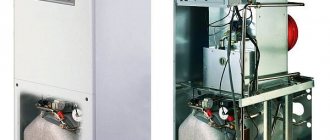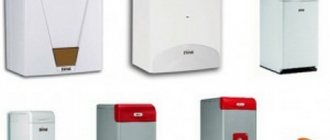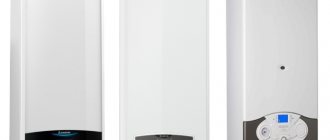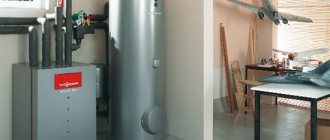A heating system for a private home can easily be created without connecting to central heating networks.
This option has recently been increasingly used by owners of houses in cottage villages located away from the main centralized lines.
Gas boilers are considered the most effective option for autonomous heating systems, which allow the owner to not monitor their operation too closely.
There are a lot of structural varieties of gas boilers that can provide certain functions.
Let's consider one of the most efficient and productive groups - floor-mounted double-circuit gas boilers.
Double-circuit floor-standing gas boilers
Floor-standing units have no weight restrictions due to installation conditions. This allows you to install more massive and durable parts in them, and use units of greater strength and performance.
Most floor-standing boilers demonstrate much higher performance due to their reliability and ability to experience increased loads without loss of performance.
The general design and operating principle do not differ from the basic design options, the whole difference is concentrated in the area of increasing the power and efficiency of the main components:
- Heat exchanger.
- Gas burner.
- Circulation pump, etc.
In addition, non-volatile models are widely used, which guarantee heating of the house regardless of the state of the electrical networks and their capabilities.
In Russian conditions, a sudden power outage, even for several hours, threatens to freeze the pipelines in the system, which means complete failure of the heating circuit.
Non-volatile boilers completely eliminate this possibility, not requiring anything other than a supply of water and gas.
Methods for igniting a double-circuit boiler
Without an automatic ignition system, few people imagine the comfortable use of gas heating equipment. There are two completely different principles that can be used for both electrically dependent and completely autonomous boilers - electric and piezo ignition.
The automation unit for piezo ignition of a double-circuit gas boiler has a simple design and resembles the device of a gas lighter (+)
The piezo ignition method operates on the same principle as ignition in a lighter - pressing a button causes a spark to appear, which starts the combustion process. In the future, control to ensure that the flame does not go out is carried out using a thermocouple.
The element is heated by the burner, generating a current that keeps the solenoid valve from slamming. During a temporary suspension, the wick still remains burning in the boiler.
Piezo ignition is often used in non-volatile boilers and is, in fact, a semi-automatic system. If the gas is turned off, the burner goes out and the valve closes, stopping further gas supply. You can restart the boiler by pressing the button.
Electric ignition provides complete automation - the heating device starts with the appearance of a spark, and the flame is controlled using an ionization control unit. When the power goes out, the automatic system is activated, it shuts off the gas, and when turned on, it starts the boiler.
In such devices there is no need for a constantly burning ignition filter, and this is a significant gas saving. You can eliminate the dependence of a boiler with electric ignition on the power supply using batteries.
Advantages and disadvantages
The advantages of floor-standing gas double-circuit boilers include:
- The ability to provide the home with heat and hot water for domestic needs.
- Less dependence of installation conditions on the material of supporting structures.
- Increased power and reliability compared to wall-mounted models.
- Ability to work in conjunction with external storage tanks.
- The ability to be connected in a cascade, when several boilers form a complex of increased power, capable of serving premises of significant area and volume.
The disadvantages of floor-standing gas double-circuit boilers should be considered:
- Heavy weight, increased dimensions.
- The need to allocate a separate room, especially for high-power models.
- As power increases, fuel consumption increases proportionally.
NOTE!
The disadvantages of floor-standing gas boilers are a consequence of their design and specific operation. When choosing a floor-standing unit, you need to know about them in advance and treat them as design features.
Prices: summary table
Comparative rating of double-circuit floor-standing gas boilers:
| Model name | DHW circuit capacity, l/min. | power, kWt | Gas consumption, m3/h. | price, rub. |
| Baxi SLIM 2.230 I | 13,4 | 22,1 | ≤ 2,59 | 125 000 |
| Protherm Bear KLZ | 12,0 | 17,0 | ≤ 2,00 | 158 500 |
| ZhMZ AKGV-3 ZHUK | 5,4 | 17,4 | ≤ 1,87 | 34 000 |
| Lemax Premium-B | 6,0 | 16,0 | ≤ 0,95 | 30 000 |
| Fondital Bali BTFS EV | 24,5 | 32,0 | ≤ 3,64 | 167 500 |
Device
The design of floor-standing gas boilers differs only in the increased strength of components and parts. There are no fundamental differences.
The main elements are:
- Primary heat exchanger. This is the main unit in which the basic function of the boiler is performed - the coolant is heated.
- Gas-burner. It is located directly under the primary heat exchanger and performs an equally important function - it is a source of thermal energy for heating the coolant.
- Secondary heat exchanger. Provides heating of hot water for domestic needs. There are different types of such units, designed for different performance and operating modes.
- Circulation pump. Present only in volatile installations. Ensures the coolant moves through the system at a given speed.
- Turbocharger fan. Available only in closed type boilers. Creates excess pressure, displacing smoke and combustion products out.
- Gas equipment. Performs the functions of supplying and timely shutting off gas in case of emergency situations.
- Control board. Present only on volatile installations. Performs the functions of monitoring the operation of all components of the boiler, ensures the stability of the coolant heating mode and the operation of all other elements. It comes complete with a self-diagnosis system - a network of sensors installed on all important parts of the unit and notifying the owner of any problems.
The operating process consists of the coolant flowing from the return line of the heating circuit into the heat exchanger, heating it using a gas burner and feeding it into the system with the specified parameters.
At the exit from the primary heat exchanger, the coolant passes through a secondary unit, where it transfers part of the thermal energy to the water flow, heating it to operating temperature.
Then the coolant enters the three-way valve, partially mixes with colder return water and receives the desired temperature, at which it enters the heating circuit.
Flue gases are removed either naturally, using a stove-type draft, or under the influence of excess pressure created by a turbofan. Its additional function is to provide a supply of fresh air that supports gas combustion.
IMPORTANT!
The most common operating cycle of a floor-standing gas boiler is described. There are other design options that have some differences.
Customer Reviews
Oleg K.
Lemax Premium-16
Italian boiler automation Lemax Premium is a guarantee of a long service life of the boiler without failures or problems. Modern boiler protection - gives complete confidence that its protection will work in the event of overheating, interruption of draft, soot formation or blowing out of the boiler. The boiler does not depend on electricity - this is the ability of the boiler to operate when the electricity is turned off. All these indicators are important to me, so I installed a Lemax Premium boiler and in 2 years I have not regretted my choice at all!
Evgeny A.
BAXI SLIM 1.230 iN, 22.1 kW
Pros: Well made! Will fit into any interior if there is no boiler room. There is access from all sides. Cast iron! Working with an indirect heating boiler. Disadvantages: It is inconvenient to connect the upper supply pipe. The thread is also internal. Doesn’t keep the flame on the socket, constantly ignites it... resulting in unusually audible popping noises every time it starts.
Ivan Chirkov
Lemax Premium-10
I installed Lemax Premium at the end of last summer. Just a couple of years ago I wouldn’t have even looked at it. Before it there was an expensive but popular unit. And I understand very well those who say that Europe is doing great. Yes it is. And when everything is fine with your expensive boiler, you live and don’t give a damn. But as soon as problems appear, that’s it. Do you know how much it costs to change a heat exchanger or automatic ignition? Yes, it’s easier to install a new boiler. I had no illusions about Lemax, but at least I knew that if something happened they would help me, our service technicians know our products better and spare parts are always within easy reach. That's why I took the course that it would be cheaper to maintain. There is little to say about the boiler itself yet. It works and doesn't make any noise. At first I was confused by the condensation that appears when it warms up to 50 degrees. But the support service assured that this was normal for such a temperature, and I myself later saw in the passport that this was written. Pah-pah, let it continue to work.
Roman Belov
Lemax Premium-20
I tried to find a powerful and compact gas boiler. For my 180 square meters (2 floors and an attic) I picked up Lemax-premium for 20 kW. During the first heating season, it seemed that I paid a lot on gas. It’s easy to control: I set it to 5-6, that is, up to 80 degrees. The boiler was ticking. But it was warm. This season I thought about saving, but the craftsmen shrugged their shoulders, saying the settings were correct. Only the neighbor came up with the idea to insulate the walls so that the warmth would remain inside. When I had already completed 2 rooms, less gas began to escape.
Klochkov Oleg
Siberia 17, 17.4 kW
An excellent boiler for the money, very heavy, more than 50 kg, which speaks of the thickness and durability of the heat exchanger steel. Piezo ignition, flame control, maintaining and regulating the set temperature using the best Italian mechanical automation. With a well-made heating system, this boiler will last a lifetime, which will not have to be repaired or even maintained.
Elena S.
Lemax Premium-10
Problems with commissioning initially spoiled the impression of Lemax. The burner went out, it was an infection. I later found out that it was due to pressure. I called the Lemax hotline, and that’s what they answered. And it seems like the gas pressure is written down in the passport, right? But the gas was still not adjusted properly, the pressure was lower, the burner went out. And so I chose a simple boiler without unnecessary automation, so that no power surges would “eat up” my brain, but here is such a setup. I had to invite the gas workers, but they screwed it up and that’s it, and it doesn’t matter that I suffered for a week
Nikolay V.
Lemax Premium-30B
Last year we selected a gas boiler for heating. We looked at more than one option and chose the Lemax Premium-30V boiler. We consulted with neighbors and gas workers. We looked on the Internet. Lemax is produced in Russia. This means they are adapted to our Russian realities, unlike imported ones. This is a floor-standing, double-circuit boiler with an open combustion chamber; combustion products are removed naturally through the chimney. It will heat the house and heat the water. Electronic control. The quality is top notch. This is confirmed by those who already use such boilers and those who service them. The boilers are reliable, and if something happens, they are repairable. Spare parts are always available and at low prices compared to imported ones. We ourselves were convinced of the quality of the boiler. Last winter, and it was frosty, he proved himself to be the best.
Lev D.
Lemax Premium-10
I installed it in the fall, at first when I started it for the first time there was something rustling inside, I thought it was a leaky heat exchanger, but everything went well - just factory paint and condensation. There was a problem: the gas went out. We figured it out - it turned out that because the exhaust pipe was made of asbestos and there was no insulation, the exhaust hood was weak and disappeared, so the automation was triggered and plus condensation formed. I insulated the pipe and the problem disappeared. For a log house of 60 m in position 3, the temperature in the house is 24 degrees while the outside temperature is -20.
Ksenia S.
Lemax Premium-30B
I specifically took a boiler from Lemax for a private home, because I already had a bitter experience with imported ones - they focus on the milder European climate, but here we have even -20, sorry. I heard only good things about the manufacturer, and a colleague advised my husband that he has Lemax, only a different model. This particular model suited us, the house is 200 m2, it is enough for him with a margin, and it is also efficient in terms of gas consumption. We haven’t regretted it even once; finally we don’t freeze in winter. It was installed for us by invited gas workers) and they did it quickly. The only thing is that it’s really, as they wrote here, a little noisy (it’s not really critical for me, but suddenly for someone it will be a problem.
Which is better - convection or condensation?
First of all, it is necessary to understand the difference between the operation of one and another unit.:
- Convection - works on the usual principle of heat transfer. The coolant is heated due to the thermal energy released during fuel combustion.
- Condensing is a boiler that produces two-stage heating of the coolant. First, the OM receives a certain amount of thermal energy from the condensation of water vapor, which is contained in the exhaust combustion products. The partially heated coolant then enters the primary heat exchanger and is finally heated in the usual way.
The advantage of condensing boilers is the ability to reduce fuel consumption and, accordingly, reduce the heating intensity of the heat exchanger. Since the liquid has already received some heat, the burner operating mode can be reduced.
All this together allows you to increase the service life of the boiler components and parts and increase its efficiency. The efficiency of condensing boilers, declared by all manufacturers, is 107-109%, although in this case the usual marketing ploy takes place.
Such efficiency cannot exist by definition, but this is not the main problem . Condensing boilers are able to demonstrate proper efficiency only in low-temperature systems, where the degree of return heating is lower than the condensate temperature.
This is only possible if the difference between external and internal temperatures does not exceed 20°, which is simply impossible in Russian realities.
Therefore, you can choose a condensing boiler only in southern regions with warm winters.
NOTE!
The price of a condensing boiler is almost twice the cost of convection models of the same power. If operating conditions do not allow you to obtain the expected effect, you should refuse to purchase a condensing model.
What is the difference between a gas boiler with an open and a closed chamber?
Boilers are also divided according to the type of chamber - it can be open or closed.
Connection diagrams for chimneys for boilers of various types
The figure shows two types of boilers:
1. A heating device with an open firebox, which is connected to the chimney.
2. The second picture shows the type of boiler with a closed chamber and turbo ventilation, i.e. using a fan and a coaxial chimney.
3. The third picture also shows a boiler with a closed firebox and turbo ventilation, but connected to a vertical chimney.
- The open type of chamber provides for the operation of the boiler using natural draft - this is a classic scheme in which air for fuel combustion enters the boiler from the room where the device is installed. This type of boiler takes in the amount of air it needs to function properly. In this case, the chimney must be connected to the chimney pipe.
The main disadvantage of such a boiler is that it is not recommended to install it in a residential area, as poisoning from combustion waste is possible. Therefore, it is necessary to equip a separate boiler room with a good ventilation system for its installation.
The positive aspects include the price of boilers with an open firebox - it is much lower, and also the fact that this type of device can operate completely autonomously, in the absence of power supply.
- The closed combustion chamber in the boiler allows it to be installed in any room with a good ventilation system, and it does not require a separate room. However, a device with a closed combustion chamber requires a forced ventilation system, i.e. fan, which means it is energy dependent. For this type of boiler, both a vertical chimney and a horizontal coaxial chimney, which is discharged through the wall, are suitable.
Types of burners and what do they affect?
Double-circuit boilers can have two types of burners - atmospheric and forced-air. How are they different and which one is better?
- Pressurized burners are equipped with a fan that draws air into the firebox. They are most often installed in a boiler with a power of 100 kW or more. The efficiency of a heating device with a forced-air burner increases to 92-95%. Such boilers are not demanding on the pressure in the gas main and the height of the chimney pipe.
Gas burner of pressurized operating principle
This type of burner will help significantly save on fuel and is often used even in boilers with combined heating. However, boiler models of this type are quite expensive, and another disadvantage is the fairly loud noise during their operation.
- Atmospheric type burners have a less complex design. Gaseous fuel is supplied to it simply under the influence of a certain existing pressure in the line, and air is supplied through normal draft. The burner has an affordable price, which reduces the cost of the entire device - this factor makes such boilers popular and in demand.
Atmospheric burner
True, the efficiency of a boiler with an atmospheric burner type is lower than that of a closed forced-air burner, and is 85-90%, so energy savings will be lower.
But these types of burners are easy to operate, operate almost silently and do not require maintenance costs.
What is the difference between non-volatile and conventional boilers?
Non-volatile boilers operate without the use of electricity. In a simplified way, their work can be represented as the functioning of a conventional gas stove heating a tank of water .
This specificity has its drawbacks - there is no self-diagnosis, coolant circulation occurs naturally, which requires specific placement of heating devices in the system. However, there is a very important advantage - such a boiler works in any conditions.
A sudden power outage, which is quite possible and often occurs due to overload and severe wear and tear of the networks, threatens users of conventional boilers with the cessation of heating their home.
For a non-volatile boiler, this event does not mean anything - it will continue to operate in the specified mode . In addition, the absence of all electrical appliances and devices greatly simplifies the boiler design, which reduces the risk of breakdown.
Controlling non-volatile boilers is simpler, although many complain about the complexity of the ignition procedure.
Rating of the 7 best models of double-circuit gas floor-standing boilers
Thanks to the detailed description of the devices, which I compiled taking into account the opinions of experts and consumer reviews, every owner will be able to make the right choice and avoid fatal mistakes when coming to a specialized store.
Protherm Bear
The first place goes to a brand popular in most countries, which produces units that best match the price and quality.
The compact installation is designed for 30 kW; the pump is capable of maintaining a given pressure when raising the liquid to the 3rd floor. Fuel is consumed economically; the protherm gas boiler burns 3 cubic meters per hour. built-in boiler for 90 liters.
Siberia 17K
Second place goes to the model with a steel heat exchanger, the equipment is non-volatile, the coolant circulates naturally.
The power of 17.4 kW is complemented by a minimum consumption per hour of 1.76 cubic meters. The dimensions are quite compact, their data looks like this: 28 by 85 by 56 cm.
Lemax Premium-12.5NB
The third line of the rating is rightfully occupied by the Lemax gas boiler, which is resistant to changes in gas pressure and does not require power supply for operation. Consumption is 0.75 cubic/hour. complemented by an Italian safety system, it modulates the flame.
Lemax Premium-12.5NB
Lemax Premium-25B
The fourth position was taken by a unit with moderate characteristics, gas consumption is 3 cubic meters per hour. This model has mechanical controls, an open combustion chamber, and weighs 88 kg. An important advantage is independence from electricity, thermal protection of the heat exchanger and anti-corrosion coating of components.
Lemax Premium-30B
Lemax Premium-30B
Fifth place. Ideal for installation in houses with an area of 200 to 300 square meters. m. The steel heat exchanger has walls of 2 mm, which affects the service life of the device. Gas consumption is 3.5 cubic meters/hour.
Lemax Premium-20B
The sixth position is assigned to a gas boiler with an open combustion chamber, the maximum consumption of blue fuel is 2.4 cubic / h. The unit is compact in size, reliable in operational terms, easy to install and adjust.
Types of heat exchanger materials – what to choose?
There are heat exchangers made of different materials:
- Stainless steel . This is the cheapest and most common option. Moreover, the initiative in assembling boilers with such components comes from the manufacturers themselves. In this way they reduce the cost of their products. Units with a steel heat exchanger demonstrate quite decent performance, but they are inferior to other types in terms of durability and operating efficiency (albeit not by much).
- Copper . Copper heat exchangers are much more expensive, but also more efficient. They are able to reduce heat loss during transmission, have a long service life, and are less prone to the formation of limescale on the inner walls of pipes. Top companies install copper components on their products.
- Cast iron . This is a common heat exchanger option specifically for floor-standing boilers. A special, plastic grade of material is used that does not crack due to temperature changes. Cast iron heat exchangers are massive and have high inertia, which somewhat slows down the initial heating, but significantly smoothes out the operating process afterwards . Typically, they have a large volume and are able to demonstrate high productivity and efficiency.
The choice of a heat exchanger for a floor-standing gas double-circuit boiler must be made based on operating conditions and hot water needs.
Experts and ordinary users recommend choosing cast iron boilers, which provide stable and even heating of the coolant, are reliable and stable in operation.
What function do heat exchangers perform?
To have an idea about this most important element of the design of a heating device and to know which one is better and more durable, you need to consider several of them.
In double-circuit boilers, bithermal or separate heat exchangers, lattice type or in the form of a coil, are installed.
- Most often, a separate heat exchanger structure is used. It consists of stainless steel plates that serve to heat hot water for consumer use. And for heating needs, this complex uses a copper heat exchanger. This model is more durable than the bithermal model, as it does not become clogged with scale longer.
- Bithermic heat exchangers consist of two copper pipes. The outer pipe is a heating circuit, and the inner pipe is for flow-through heating of water for consumer needs.
Bittermic type heat exchanger
Such a boiler will cost much less than the first one, since it practically does not have a second heat exchanger and does not require a three-way valve. The downside is that this system cannot be used with hard water that is overly enriched with salts.
In addition, heat exchangers are made of steel or cast iron.
- The steel heat exchanger is lightweight and affordable. An element made of this material easily withstands possible hydraulic shocks and is not subject to deformation.
Steel heat exchanger of a double-circuit boiler
But its disadvantages include susceptibility to corrosion that occurs under the influence of condensate, which can form at low temperatures inside the boiler body, as well as the possibility of rapid burnout. These problems usually arise when the device is not used properly, but if you follow all the manufacturer’s recommendations, you can avoid such unpleasant consequences. For example, it is unacceptable that in a boiler with a steel heat exchanger the temperature drops to critical, i.e. below the dew point.
Some models use heat exchanger elements made of stainless steel or alloy steel, and, in addition, use other modern technological solutions that do not allow condensation to form. Boilers equipped with such heat exchangers are significantly more expensive than conventional ones.
- A heat exchanger made of cast iron is considered the most reliable and durable - it is not subject to deep corrosion and burnout, since the body is of sufficient thickness. But you need to remember that cast iron is fragile, and even with a slight impact, cracks can form on it. In addition, similar damage can occur when cold water enters a heated heat exchanger, for example, when the system is replenished with water.
Cast iron heat exchangers
If the water has a high percentage of hardness salts, a large layer of scale can quickly form in the boiler, which leads to overheating of individual parts of the heat exchanger, and as a result, the formation of cracks and failure of the entire heating apparatus. Thus, it is imperative to install a water softening system in front of the heating circuit.
In expensive boilers, heat exchangers are installed from special grades of cast iron, with special plasticity of the material, resistance to corrosion and homogeneity of structure. Such elements serve in boilers for about fifty years.
But, it should be noted that for gas-powered appliances, a cast iron heat exchanger is not particularly desirable. The fact is that cast iron, due to its massiveness, has high thermal inertia and cannot quickly change the temperature in the circuit, even if the automation switches the boiler to a different power. And this is not very good either for the automation of the device or for other structural elements.
Types by type of smoke removal and which one is better?
There are two types of smoke removal systems:
- Open (atmospheric). It works on the principle of stove draft; smoke is removed through a common house or its own vertical chimney.
- Closed (turbocharged). The smoke is forced out by the turbocharger fan.
Natural cravings are unstable and depend on many external factors. Sometimes a reverse draft occurs, which, instead of removing the smoke, begins to draw it indoors.
Turbocharged boilers are completely free of such problems and demonstrate a stable smoke removal regime in any conditions. This makes the choice of atmospheric installations less attractive, however, all non-volatile boilers operate on this principle.
In order to get rid of possible problems, external additional devices are used - turbo nozzles.
They help stabilize and equalize the smoke removal regime, although they can only work if there is a power supply.
Characteristics and operating principle
Gas boilers, like other water heating devices, are designed to heat the coolant. As a rule, this is water; with the help of heat from gas combustion, it is heated and subsequently used for heating premises. If you install such equipment in a private home, you can forget for a long time about buying firewood and coal, which you have to spend a lot of money on.
Natural or liquefied gas is used as fuel. This is due to two reasons:
- Gas is quite cheap, which allows you to heat residential and non-residential premises at minimal cost.
- The use of gas allows the use of automatic control and fire safety systems, which makes gas boilers safer.
How does a gas boiler work?
Although such equipment may have different designs, the principle of operation is the same for all. With the help of a match, and in modern equipment with the help of electric ignition, the igniter is ignited. This little wick burns constantly.
Then gas is supplied into the chamber using automation, which, when burned, heats the water. The coolant is heated to a certain temperature, then the access to fuel is blocked. As soon as the water temperature drops to low values, the gas is again supplied to the combustion chamber, thereby heating the water.
How to choose power for a room and calculation formula
The power of gas boilers is selected based on the area of the premises. The simplest formula is that 1 kW of boiler power is taken into account per 10 m2 of area.
This technique is most effective for rooms with a height of no more than 3 m . If the ceilings are higher, it is necessary to slightly reduce the ratio of the size and power of the unit.
For double-circuit boilers, the power should be increased by 20% to compensate for losses in water heating.
Difference in power level
Floor heating boilers are divided into working ones:
- at one power level, they are called single-stage;
- at two power levels, called two-stage;
- continuously adjustable, called boilers with modulation.
Practical observations show that during the entire cold season, the boiler’s full capacity is used only 15-20 times, and the rest remains unclaimed.
From this circumstance we can conclude that the best purchase would be a boiler with modulation or two-level power, which will allow it to be adjusted to a specific temperature outside the window. The positive qualities of these options for heating devices include:
- longer operating life, which is achieved by reducing power at the right time;
— increase in environmental qualities, as the emission of combustion waste into the atmosphere is reduced;
— it is possible to connect, if necessary, additional water heating equipment.
Types of ignition methods and which method is the most optimal?
There are two types - electric ignition and piezo ignition. The first option is used on volatile boilers and occurs automatically after setting the desired coolant temperature.
Piezo ignition is a method used on non-volatile units. The specifics of such a launch are much more complicated and require a certain procedure.
Electric ignition is much simpler, faster and more reliable, but in the absence of electricity, you have to use the available options.
The best known manufacturers and models: characteristics and prices
Single-circuit
Protherm Wolf 16 KSO
The best model for today in terms of price-quality ratio. This is an inexpensive, energy-independent boiler with mechanical control and a steel, but quite high-quality and reliable two-pass heat exchanger. It is also distinguished by its high efficiency, for example, the 16 kW model has an efficiency of 92.5% with a maximum gas consumption of 1.9 cubic meters. m/hour. A traction stabilizer is included in the kit.
Owners often note almost silent operation even when igniting the burner; the boiler is not known for problems with the burner being blown out by the wind. In general, both all products of the Slovak company Protherm, and this model in particular, rarely raised questions. Through practice of installation and operation, the boiler has proven itself to be trouble-free, and this is not surprising, since there is practically nothing to break in such a simple design. On a pleasant note, it is also worth noting that in addition to a standard thermometer, the boiler is also equipped with a pressure gauge and overheating protection.
The only thing is that the maximum permissible operating pressure of the boiler is only 1 bar, so it is not intended for use in closed heating systems with a circulation pump. Available in 12.5 and 16 kW versions.
Lemax Premium-16
Another energy-independent atmospheric floor-standing gas boiler, but of Russian production. It is equipped with a steel, but thinner (2 mm) heat exchanger than the previous Protherm Wolf KSO (3 mm), and it is slightly inferior in efficiency. Efficiency is 90%, the maximum gas consumption for the 16 kW model is 1.9 m3/hour. Automation is the well-known Italian EuriSIT, there is protection against overheating, the maximum permissible operating pressure is 3 bar, the boiler can be installed in systems with forced circulation of coolant.
There are more disadvantages in the case of Lemax Premium: mediocre build quality, demanding initial setup and chimney. There are problems with reverse draft (blowing), and in general, service calls are more common. However, despite all the features described above, almost any specialist considers the model to be one of the three recommended among budget atmospheric floor-standing boilers. Available in versions with a power of 7.5; 10; 12.5; 16; 20; 25; thirty; 35; 40; 50; 60; 70; 80; 90; 100 kW. Dual-circuit analogues come with the prefix “B”, for example, Lemax Premium-16V.
Review of Lemax gas boilers Some of the most popular domestic boilers
Baxi SLIM 1.150i 3E
Well-known Italian atmospheric model with a cast-iron durable heat exchanger. Requires connection to the electrical network, is equipped with a modulating burner, has a built-in 10 liter expansion tank, circulation pump, safety valve and air vent. The efficiency is 90.3%, according to the manufacturer, even at minimum power it does not fall below 89.5%, the maximum gas consumption for the 14.9 kW model is 1.74 m3/hour. Thanks to electronic control, the boiler has the functions of auto-diagnosis, auto-ignition, protection against overheating and freezing, and blocking the circulation pump.
According to operating practice and reviews from owners, the boiler is absolutely problem-free even with minor violations of operating conditions. It is not demanding on the quality of the coolant; owners often note the practical dimensions, since the width is only 35 cm. The boiler operates almost silently, it is possible to connect heated floors and external control (thermostat). It can also be reconfigured for liquefied gas. Available in power versions: 8.5; 11.8; 14.9; 20.6; 24.5; 31.6 kW.
Protherm Bear 30 KLOM
No less famous Slovak cast iron energy-dependent analogue. Features a slightly more efficient two-pass heat exchanger design at a lower price. Efficiency – 92%, maximum gas consumption for the 26 kW model – 3 cubic meters. m/hour. The expansion tank and circulation pump are not built in as standard.
Otherwise, the boiler has the same functionality as the previous Baxi SLIM: modulating burner, auto-diagnosis, auto-ignition, protection against overheating, freezing, blocking of the circulation pump, external control can be connected. The model fits perfectly with external boilers, since it can control the temperature in them and the circulation pump of a small water circuit (between the boiler and the boiler).
According to installation and operation experience, it can also be considered problem-free; in addition, owners often note a pleasant bonus in the form of an official guarantee for as long as 10 years. The only drawback is the sensitivity of the electronics to voltage changes; with a very poor power supply, it can generate errors (the most common is F 01), sometimes turning the plug in the socket to the other side helps. Even with a warranty, it is advisable to connect the boiler through a voltage stabilizer or UPS. Available in power versions: 17; 26; 35; 44.5 kW.
Vaillant atmoVIT VK INT 164/1-5
The reference German atmospheric model, one of the best floor-standing gas boilers for heating a private home. It is distinguished by the highest reliability, quality of workmanship and assembly, efficiency, and pleasant design. The heat exchanger is cast iron, and the boiler is energy-dependent; the peculiarity is that it is extremely efficient even at low temperatures (wide radiators and coolant temperature up to 50°C). Efficiency is 92%, and the maximum gas consumption for the 16.9 kW model is 1.9 cubic meters. m/hour.
The main feature of this model is the INT marking, which implies adaptation to more unfavorable Russian conditions, so in practice, malfunctions in this model are extremely rare. Also, in addition to the standard functionality present in the models above, it is worth noting the presence of a thrust tipping sensor (reverse thrust). There is a layer of thermal insulation between the heat exchanger and the boiler body, which reduces heat loss through the body. Apart from the high cost, it is difficult to find any disadvantages. Available in power versions: 16.9; 25; 31.5; 41; 48.9; 56 kW.
Review of Vaillant gas boilers Reference German quality, reliability and manufacturability
Dual-circuit
Baxi SLIM 2.230 I
A dual-circuit analogue of the previously reviewed Baxi SLIM 1.150i. Cast iron heat exchanger, electronic control with the same functionality and safety systems, efficiency - 90.2%, maximum gas consumption for the 22.1 kW version - 2.59 m3/hour. It is still equipped with a built-in expansion tank and circulation pump, and has the ability to connect external control.
It is distinguished by the accumulative principle of preparing hot sanitary water: inside the structure there is a 50-liter storage boiler, which always contains already prepared water. Further, the productivity of the hot water kennel is 12.1 l/min at a water temperature of 35°C, which is a fairly high indicator. The only drawbacks are the high price and heavy weight (176 kg for the 22.1 kW version). Available in 22.1 and 29.7 kW versions.
Protherm Bear 20 KLZ
Cast iron volatile boiler with a built-in boiler for as much as 90 liters, which is enough for a bath and shower. Efficiency – 90%, maximum gas consumption at a power of 17 kW – 2 m3/hour. The burner is modulating, with automatic ignition, there are all modern protection systems: from overheating, freezing, stopping the circulation pump. The basic configuration includes a built-in expansion tank, circulation pump, and air vent. It is possible to connect external control. The capacity of the DHW circuit is 16.5 l/min at a temperature of 30°C.
Owners often note a fairly quick supply of hot water after opening the tap. The main disadvantage is the vulnerability of the electronics to voltage surges (from stopping work with error F 01 to failure of the board), so we recommend connecting the boiler through a voltage stabilizer or UPS. Also, in more powerful versions used in houses with an area of 300 m2 or more or 3 or more storeys, the performance of the complete circulation pumps is often not enough. Available in 17, 26, 35 and 44.5 kW versions.
Lemax Premium-16 B
Low-cost, non-volatile steel boiler of domestic production. Efficiency is 90%, the maximum gas consumption for the 16 kW model is 1.9 m3/hour. Automation - the famous Italian EuriSIT, there is protection against overheating. Water is prepared using the flow heating principle with a capacity of only 5 l/min at a temperature of 30°C.
In general, the model is characterized by the same disadvantages as its single-circuit analogue Lemax Premium-16: poor build quality, the need for proper commissioning, increased requirements for the chimney and problems with reverse draft. Despite the fact that the boiler is seriously inferior to foreign analogues described earlier, it is still an excellent and extremely cheap option for organizing heating and hot water supply. Available in power versions: 12.5; 16; 20; 25 and 30 kW.
BAXI LUNA 3 Comfort Combi 1.240 Fi
One of the best among double-circuit floor-standing gas boilers for heating a private home. Firstly, the model differs from the previous ones in its copper primary heat exchanger: more resistant to corrosion than steel, but not as durable as cast iron. On average, the service life of a copper heat exchanger in floor-standing boilers is 17-18 years.
Secondly, already in the basic configuration, in addition to all modern security systems, the boiler is equipped with a programmer, a room thermostat and a remote control. There is a built-in expansion tank, circulation pump, safety valve, air vent, water filter. Efficiency is 92.9%, and the maximum gas consumption at a power of 25 kW is 2.84 m3/hour.
The DHW circuit is heated according to the accumulative principle; the volume of the built-in boiler is 80 liters. DHW capacity is 9.8 l/min at a temperature of 35°C. The use of a copper heat exchanger made it possible to significantly reduce the cost of the boiler and add extremely useful functionality such as a programmer. Available in 25 and 31 kW versions.
Popular companies
Let's look at the most popular brands and models of floor-standing gas boilers:
- Vaillant . A popular German company, which is considered a leader in the production of thermal products among European manufacturers. It produces a wide range of equipment, which includes a large selection of floor-standing dual-circuit models.
- Buderus . An outstanding German manufacturer whose floor-standing boilers are widely known throughout the world. The Logano series consists of many models with optimal parameters for any room.
- Viessmann. A German concern that produces a large amount of equipment of various types. Floor-standing gas boilers are distinguished by their durability, high build quality, and reliability.
- Baxi . A famous Italian company producing high-quality gas units. The Baxi Slim and Power HT series represent floor-standing boilers with extensive capabilities and many additional functions.
- Ferroli . This is another Italian company known for its quality and reliability. Floor-standing boilers are presented in 7 series under the general name Pegasus. They have a wide range of capabilities and allow you to choose an option for any working conditions.
- Protherm . A Slovak company that names each series of its boilers after an animal. Double-circuit floor models are represented by the Bear series, capable of heating rooms up to 440 m2.
- Navien . Korean manufacturer of inexpensive and efficient gas boilers.
- Kiturami . Another Korean company that produces the STS GAS series of two models. The units are distinguished by high performance combined with low prices, which is typical of all Korean products.
- Daewoo . Floor-standing boilers from this world-famous company demonstrate high performance combined with affordability.
- Fondital . An Italian brand representing floor-standing double-circuit boilers of the Bali series, designed for heating and supplying hot water to residential, public and office premises of various sizes.
- Siberia . A domestic company that produces energy-independent floor-standing models for use in private homes. The power of the units is in the range of 11-50 kW.
The list of boiler manufacturers is much wider, but not all of them produce double-circuit models, specializing in installations with external additional boilers.
Use of coolants in boilers
If irregular residence or frequent and long-term departures are planned at a dacha or in a private house, and draining and purging liquid from the system is not considered an acceptable option, then it is necessary to prevent it from freezing.
This can be done by adding antifreeze to the coolant - substances that do not freeze to a certain negative temperature, and in the case of even lower temperatures do not harden, but turn into a gel-like substance without increasing in volume.
In most cases, it is not recommended to use antifreeze in double-circuit floor-standing boilers running on gas (these standards are less stringent for single-circuit boilers). The instructions clearly state that the coolant in the heating system must be water.
If the user, at his own peril and risk, fills the heating system with any other solution rather than prepared water, then problems arising due to this are not covered by warranty.
Some manufacturers indicate a specific brand of antifreeze that can be used to fill the heating system. For example, equipment manufacturer Viessmann Antifrogen brand coolant .
Others indicate that, as an exception, antifreeze can be used if its manufacturer guarantees that the product will not cause harm to the components and materials of the boiler, in particular the heat exchanger. It is necessary to take into account that for a certain model one coolant may be suitable and another may not be suitable at all.
Therefore, if it is important that antifreeze is used as a coolant in the heating system, you need to find out in advance, before purchasing, whether it is possible, and if so, what brand of coolant is allowed to be used for a specific brand and model of the boiler.
Volatile and independent models
It is also worth making a choice in favor of a non-volatile or electricity-dependent boiler. In the first case, even a power outage will not affect your heating system. But such floor-standing boilers are not equipped with powerful automation. You will have to do all the adjustments manually, and this is sometimes difficult and unsafe.
If your equipment is equipped with powerful and reliable automation, then servicing it will be easy. But in this case, your house must be connected to a reliable source of electricity, because if there is no current, the boiler will turn off, which means the house may get colder.











